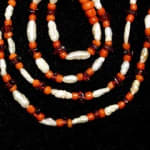Freshwater Pearl, Coral Bead, Garnet Bead Necklace
Freshwater Pearls
FB.0169
Further images
The delicate, lustrous beauty of the pearl has captured the imagination of men and women since the dawn of time. This gorgeous gem is formed when an irritant becomes trapped...
The delicate, lustrous beauty of the pearl has captured the imagination of men and women since the dawn of time. This gorgeous gem is formed when an irritant becomes trapped inside the shell of a mollusk, and a protective coating of nacre is formed around the object. Pearls are one of the few jewelry items to remain continuously in fashion through the centuries. It is easy to see why. They delight the eye and flatter the wearer, a true gift from nature.
For centuries, coral-- like pearl, a gift of the sea-- was classed among the precious gems valued by man. Not strictly a mineral, coral is an organic substance, composed of the skeletons of millions of tiny marine animals. In its natural state, coral is plantlike in appearance and grows in warm water at depths of up to ninety feet. In hue, it varies from white, to pink, to red or orange, to black. Coral jewelry is known from the Egyptian, Biblical, Classical and Islamic periods. Coral is used as a heart stimulant, as an antidote for fevers and toxins in the body, and for preventing vomiting, colic, and childhood diseases. Its mysterious strength seems to derive from its organic source material, the accumulated energy of living things.
The garnet was highly prized in the Classical world. Its rich color, the reddish purple associated with royalty, made it especially sought after for jewelry. The garnet was also favored in the jewelry of the European Dark Ages and Medieval period. The famous Sutton Hoo Treasure found in England contains over 4,000 cut and faceted garnets. As with many gems, the finest varieties come from India, which was true in Antiquity as well as today. According to Talmudic legend, the only source of light on Noah's Ark was a single large garnet. Therapeutically, garnet is believed to keep the wearer free from wounds and to promote good health in general. It is especially useful for preventing skin disorders and giving a glowing complexion.
For centuries, coral-- like pearl, a gift of the sea-- was classed among the precious gems valued by man. Not strictly a mineral, coral is an organic substance, composed of the skeletons of millions of tiny marine animals. In its natural state, coral is plantlike in appearance and grows in warm water at depths of up to ninety feet. In hue, it varies from white, to pink, to red or orange, to black. Coral jewelry is known from the Egyptian, Biblical, Classical and Islamic periods. Coral is used as a heart stimulant, as an antidote for fevers and toxins in the body, and for preventing vomiting, colic, and childhood diseases. Its mysterious strength seems to derive from its organic source material, the accumulated energy of living things.
The garnet was highly prized in the Classical world. Its rich color, the reddish purple associated with royalty, made it especially sought after for jewelry. The garnet was also favored in the jewelry of the European Dark Ages and Medieval period. The famous Sutton Hoo Treasure found in England contains over 4,000 cut and faceted garnets. As with many gems, the finest varieties come from India, which was true in Antiquity as well as today. According to Talmudic legend, the only source of light on Noah's Ark was a single large garnet. Therapeutically, garnet is believed to keep the wearer free from wounds and to promote good health in general. It is especially useful for preventing skin disorders and giving a glowing complexion.





